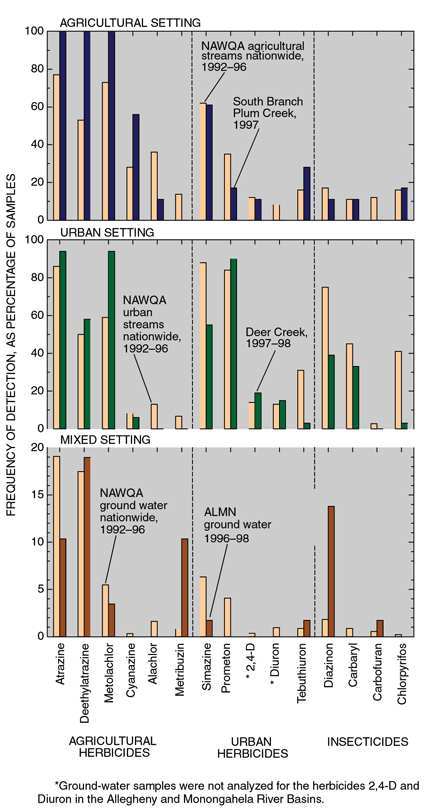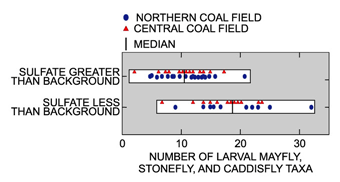MAJOR FINDINGS—Continued
Pesticides are at Low Concentrations when Detected in Ground Water
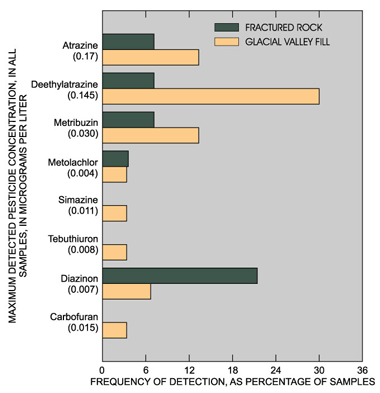 |
| Figure 12. With exception of diazinon, pesticide-detection frequencies in ground water were higher in the valley-fill aquifers than in the fractured-rock aquifers. (Not shown above is the herbicide EPTC detected in a single sample—0.004 µg/L.) |
Ground-water samples from 58 shallow domestic wells throughout ALMN were analyzed for pesticides. One to five pesticide compounds were detected in 34 percent of the samples. Nine different compounds were detected at concentrations ranging from less than 0.001 to 0.17 µg/L. All detections were at or below the methoddetection limit. No compounds were detected above drinking water-quality guidelines or standards. The five most frequently detected compounds were the agricultural herbicides atrazine, metribuzin, and metolachlor; the insecticide diazinon; and a breakdown product of atrazine, deethylatrazine. Of the 58 ground-water samples analyzed for pesticides, 30 samples were from wells in valley-fill aquifers and 28 samples were from fractured-rock aquifers (see page 22). Forty percent of the samples from valley-fill aquifers and 29 percent of the samples from fractured-rock aquifers contained at least one pesticide compound. Deethylatrazine was the only pesticide detected in more than 30 percent of all samples in the valley-fill aquifers. No pesticides were detected in more than 22 percent of sampled wells in the fractured-rock aquifers. Nine different pesticide compounds were detected in 12 samples from the valley-fill aquifers (fig. 12). The top four detected compounds in samples from valley-fill aquifers were deethylatrazine, atrazine, metribuzin, and diazinon. Two or more pesticide compounds were detected in 20 percent of the samples in the valley-fill aquifers.
Volatile Organic Compounds were Detected at Low Concentrations in an Urban Stream
Volatile organic compounds derived from substances commonly used in residential and urban areas, such as gasoline and cleaning solvents, were detected in 24 of the 25 samples collected from Deer Creek (Pittsburgh metropolitan area) in 1997–98. Of the 87 VOCs analyzed for, 22 VOCs were detected at least once, and 55 percent of those detected were gasoline-related compounds (fig. 13). All measured concentrations of VOCs were well below drinking-water standards and guidelines.
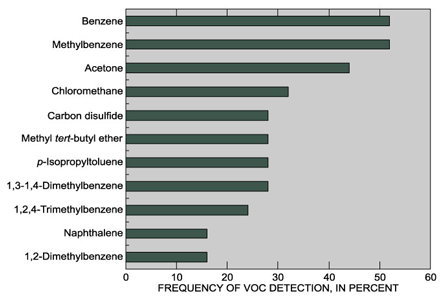 |
| Figure 13. Of 87 VOCs analyzed for, 22 were detected in Deer Creek at Dorseyville, Pa. The 11 most frequently detected VOCs are shown. |
The occurrence of benzene, methylbenzene, methyl tert-butyl ether (MTBE), 1,3-1,4-dimethylbenzene, and naphthalene showed evidence of seasonality in samples collected in 1997. All five compounds were detected in samples collected in February, November, and December, but were absent in samples collected in July, August, and September (fig. 14). Water temperature is a significant factor affecting the concentration and detection of VOCs. VOCs are more likely to be stable and detectable in cold water than in warm water. Warm temperatures tend to cause VOCs to be driven into the atmosphere. VOC concentrations in water can increase by a factor of about 3 to 7 when water temperatures decrease from 25°C (Celsius) to 5°C (Lopes and Bender, 1998).
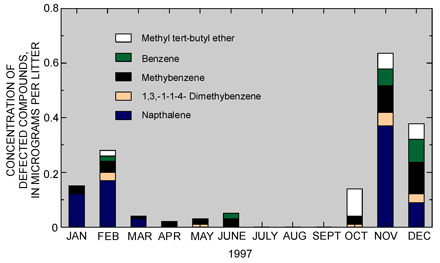 |
| Figure 14. Volatile organic compounds were detected most often and at highest concentrations in surface-water samples in cool seasons (data from Deer Creek at Dorseyville, Pennsylvania). |
VOCs can accumulate on impervious surfaces and can be flushed into the receiving stream during storms. Data from five storm samples collected in Deer Creek on August 25–26, 1998, showed that the maximum measured concentrations of acetone, carbon disulfide, benzene, 1,2,4-trimethylbenzene, and p-isopropyltoluene in a sample were collected as streamflow increased. The lowest concentrations were observed in the last samples collected as the stream receded. The concentration pattern demonstrates a flush-off effect as rains washed VOCs from the land surface to the stream (fig. 15). Fourteen VOCs detected in a sample collected on December 10, 1997, may have resulted from a flush of accumulated VOCs from impervious surfaces in addition to a low water temperature (5.0°C). Of the 14 VOCs detected, 10 were gasoline-related compounds.
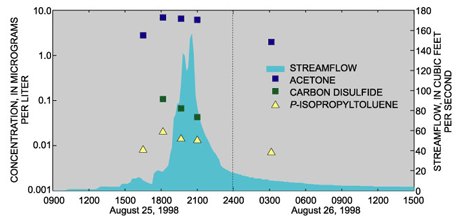 |
| Figure 15. At Deer Creek, some VOCs are rapidly transported to streams during storms. These tend to become most concentrated before the floodwaters peak and decline before water returns to prestorm levels. |
|
The commonly detected pesticides in South Branch Plum Creek, an agricultural basin, and in Deer Creek, an urban basin, were similar to the 15 most commonly detected pesticides in streams in NAWQA studies during 1992–96. The compounds detected in ground water from wells set in both valley-fill aquifers and fractured-rock aquifers are also among those most frequently detected in mixed land-use aquifers nationwide.
|
Low Levels of Volatile Organic Compounds were Detected in Most Domestic Wells Sampled
Of the 95 domestic wells throughout ALMN from which samples were collected for VOC analysis, at least one compound was detected in each of 87 samples (92 percent). A total of 28 different compounds were detected overall. Most samples (60 percent) contained two or more VOCs at detectable levels, and one sample contained seven different VOCs.
All VOC detections were at low concentrations. Twelve VOCs were detected at concentrations at or above 0.1 µg/L, including the four most frequently detected compounds (fig. 16). Of the 28 detected VOCs, drinking-water standards have been established for 20. None of the VOCs detected exceeded established drinking-water standards or guidelines.
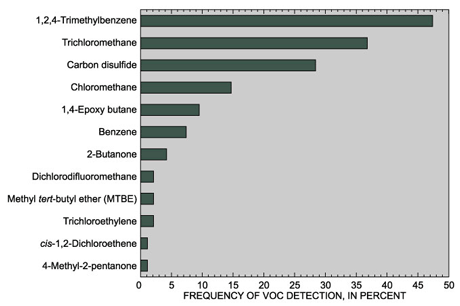 |
| Figure 16. VOCs detected in ALMN ground water at concentrations greater than 0.1 microgram per liter. |
Thirty of the water samples analyzed for VOCs were from wells downgradient from recently reclaimed surface coal mines (mined sites), and 15 of the water samples were from wells in areas underlain by coal but undisturbed by mining (unmined sites). Perhaps as a result of mine machinery use, fuel spills, or adjacent land use, gasoline-related compounds (1,2,4-trimethylbenzene, benzene, methylbenzene, and ethylbenzene) were detected more frequently and at higher concentrations in the samples collected from the mined sites, where these compounds were detected in 29 of 30 samples, compared to 9 detections in 15 samples from unmined sites.
Nitrate is Common in Streams and Ground Water
 |
| Figure 17. Livestock in South Branch Plum Creek, as in many agricultural basins, contribute nitrate to the ecosystem. |
Nitrate is a nutrient that can affect water used either as a drinking source or as a medium for aquatic life. Nitrate is present naturally in surface water, but elevated concentrations can result in abundant algal growth and toxicity to some aquatic organisms. In well water, nitrate can be a significant health risk at high concentrations. The use of commercial and organic fertilizers and the combustion of fossil fuels has been linked to elevated nitrate concentrations in streams and shallow ground water nationwide (U.S. Geological Survey, 1999a).
In ALMN, 10 stream sites and 95 domestic wells were sampled for nitrate. Samples were collected monthly at the stream sites and once at each well during the period October 1995 through September 1998. Nitrate was detected in all surface-water samples and in 62 percent of ground-water samples. Among wells and streams, only one sample exceeded the USEPA MCL for nitrate in drinking water. The sample was collected from a domestic well in an agricultural setting. The highest median concentration of nitrate in wells and streams was in a stream in an agricultural setting, South Branch Plum Creek (fig. 17).
The role of land use on the observed nitrate concentrations was investigated by comparison with a national background concentration for nitrate. The background concentration was estimated from samples collected in undeveloped areas (U.S. Geological Survey, 1999).
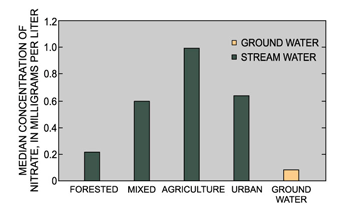 |
|
| Figure 18. Median concentrations of nitrate in streams were higher than those found in ground water. |
Nitrate concentrations in surface-water samples from forested areas in ALMN were less than national background concentration. Among other land uses with potential nitrate sources, concentrations of nitrate often exceeded the background level (figs. 18 and 19).
Activities typical of agriculture and urban/residential land use can lead to an increase in nitrate concentrations. Seasonal fertilizer applications, animal waste, and sewage are common sources of nitrate. Of the sampled streams in ALMN, 73 percent of samples from a stream draining an agricultural area exceeded background nitrate concentrations. In more populated areas (population density greater than 150 people per square mile), 54 percent of stream samples had nitrate concentrations that exceeded background concentrations.
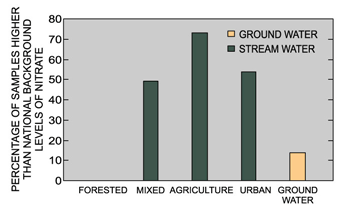 |
| Figure 19. Streams in agricultural areas had the highest percentage of samples that exceeded national background levels for nitrate (0.6 milligrams per liter in streams and 2.0 milligrams per liter (U.S. Geological Survey, 1999a) in shallow ground water). |
Overall, streams in basins that integrate various land uses within ALMN had lower concentrations of nutrients than those dominated by either dense population or agriculture. Areas with both high population density and significant agricultural acreage exceeded background nitrate concentrations in 49 percent of stream samples.
Ground-water samples analyzed for nitrate were collected from wells in areas of mixed land use. Consequently, no agricultural-urban comparisons could be made for nitrate in ground water.
| Why is nitrate important? Nitrate is the primary form of nitrogen dissolved in streams and ground water. Nitrate forms naturally in soil from transformations of nitrogen, nitrogen-based fertilizers, and manure. Nitrate is the most widespread contaminant in ground water. Because most ground water eventually discharges to streams, the nitrate in ground water can pose a potential threat to surface-water quality. Surface runoff in areas where commercial fertilizers are used, as well as discharges from wastewater treatment facilities, can also contribute nitrate to streams. Human ingestion of water with nitrate concentrations in excess of the MCL (10 mg/L as nitrogen) can lead to methemoglobinemia, or “blue-baby syndrome,” a sometimes fatal blood disorder in infants. |
Radon in Ground Water is Common but Highly Variable
Radon is a radioactive gas that is produced naturally in rocks and soils as an intermediate product in the decay of uranium-238. Radon in ground water originates from nearby soil and rock and is a potential contributing source of radon in indoor air. Exposure to airborne radon has been identified by the U.S. Surgeon General as the second leading cause of lung cancer in the United States. About 20,000 deaths per year in the United States are attributed to airborne radon (U.S. Environmental Protection Agency, 1999b).
Radon concentrations in 56 percent of the 95 ground-water samples analyzed for radon were greater than 300 pCi/L (picocuries per liter), the USEPA proposed standard for drinking water. About 19 percent of the 95 samples exceeded 1,000 pCi/L (fig. 20). Two percent of the 95 samples exceeded the proposed Alternative Maximum Contaminant Level (AMCL) standard of 4,000 pCi/L. To comply with the AMCL, a State or local water utility must develop indoor air radon-reduction programs and reduce radon levels in drinking water to 4,000 pCi/L (U.S. Environmental Protection Agency, 1999b).
 |
| Figure 20. Radon concentration in ground water varied considerably within well groupings sampled in the Allegheny and Monongahela River Basins. |
Large variation in radon concentration was found in ground water from the two aquifer systems sampled. Samples from wells in the valley-fill aquifers had a median radon concentration of 665 pCi/L; the median for samples from wells in the fractured-rock aquifers was 350 pCi/L. The higher radon concentrations in water of the valley-fill aquifers may be due to higher uranium content of the valley-fill deposits or may derive from the rock underlying these deposits. Samples from wells downgradient from recently reclaimed surface coal mines had a median radon concentration of 236 pCi/L. By comparison, water samples from wells in areas underlain by coal undisturbed by mining had a median radon concentration of 530 pCi/L. This difference may be due to several factors, such as (1) replacement of high-radon content overburden with lower-radon content backfill or (2) a greater release of radon directly to the air and less entrapment in ground water after ground disturbance caused by surface mining.
Is radon a risk from your well? The only way to be sure of radon concentration in ground water from a specific well is to have it tested. The U.S. Surgeon General recommends testing of indoor air radon levels in all homes (and apartments below the third floor). The USEPA-recommended action level for indoor air radon levels is 4 pCi/L. The USEPA recommends testing well water for radon in homes where indoor air levels of radon are high. High concentrations of radon in well water can significantly contribute to airborne levels indoors. Although few of the 95 wells that were tested in ALMN had high concentrations of radon, the results show considerable variability (fig. 20). Ground water from each well should be checked if radon is a concern. If a large part of the indoor radon is from ground-water contribution, the USEPA recommends water treatment to remove radon. |
| REGIONAL STUDIES: Sulfate concentrations and biological communities in Appalachian coal areas indicate mining-related disturbances despite a general water-quality improvement between 1980 and 1998 |
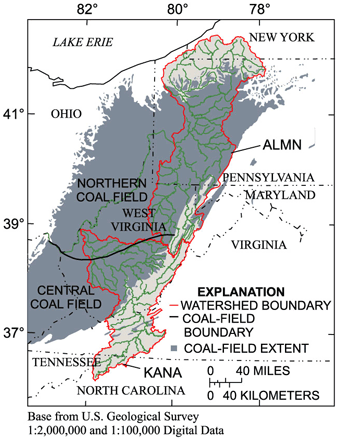 |
| Figure 21. Coal-bearing rocks underlie 55 percent of the area sampled in the Northern and Central Appalachian bituminous coal fields. (Coal-field locations from Tully, 1996) |
In a 1998 study to assess regional water-quality effects of coal mining (Eychaner, 1999), samples representing the Northern Appalachian coal field were collected in the Allegheny and Monongahela River Basins (ALMN), where high-sulfur coal is common and acid mine drainage was historically severe, and samples for the Central Appalachian coal field were collected in the Kanawha-New River Basin (KANA), where acid drainage is uncommon (fig. 21).
Water chemistry in 178 wadeable streams was analyzed once during low streamflow in July and August 1998. Drainage area for most streams was between 4 and 80 mi2. Most (170) of these stream sites were also sampled during a 1979–81 study on the effects of coal mining (Britton and others, 1989), before implementation of Surface Mine and Reclamation Control Act (SMCRA) Regulations began to affect regional water quality. At 61 sites, aquatic invertebrates (insects, worms, crustaceans, and mollusks) also were collected. Ground water was sampled from 58 wells near coal surface mines and 25 wells in unmined areas.
Water-Quality Characteristics Targeted by SMCRA Improved in Streams, but Sulfate and Metals Remain High at Some Sites
Median pH increased and median total iron and total manganese concentrations in streams decreased among mined basins between 1979–81 and 1998 in both coal fields, a reflection that these water-quality characteristics are regulated in mine discharges. Concentrations of sulfate, which is not regulated in mine discharges, exceeded regional background levels at sites downstream from mining (average of about 21 mg/L sulfate in basins with no history of mining) in more than 70 percent of samples.
The highest sulfate concentrations were measured in basins with the greatest coal production. About one-fourth of all samples exceeded 250 mg/L, the USEPA Secondary Maximum Contaminant Level (SMCL) for drinking water, and all these exceedences were in mined basins (fig. 22). When coal mining ceases within a basin, sulfate concentrations gradually decrease (Sams and Beer, 2000).
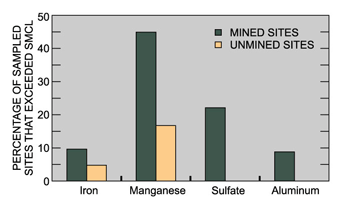 |
|
| Figure 22. Stream water exceeded Secondary Maximum Contaminant Levels at mined sites more often than at unmined sites. |
Manganese, aluminum, and iron at stream sites in many mined basins also exceeded regional background concentrations (table 1). In the 1998 samples from the northern coal field, median total iron was about equal among mined and unmined basins; but in the central coal field, median total iron among mined basins was lower than among unmined basins. In both coal fields, median total manganese among mined basins was about double that among unmined basins. Exceedences of SMCLs for dissolved iron and manganese were more common in mined basins than in unmined basins, and the aluminum SMCL was exceeded in mined basins only.
Invertebrate-Community Impairment Appears Related to Amount of Mining
Invertebrate communities tended to be more impaired in mined basins than in minimally altered basins. Pollution-tolerant species were more likely to be present at mined sites than at unmined sites, whereas pollution-sensitive taxa were few or absent in heavily mined basins. Both an increased sulfate concentration and a decline in some aquatic-insect populations was related to coal production (fig. 23). At sites where sulfate concentrations were above the estimated background level (table 1), the number of taxa of three groups of sensitive insect species (mayflies, stoneflies, and caddisflies) was reduced, although the pH was 6.5 or greater at all these sites.
At the concentrations measured, the sulfate ion is relatively nontoxic to aquatic organisms and may not represent the cause of the decline in mayflies, stoneflies, and caddisflies observed. Sulfate is, however, related to the total coal production from a basin (Sams and Beer, 2000). Invertebrate communities may also have been impaired by other large-scale landscape disturbances—for example, changes in hydrology, siltation, or trace-metal contamination, all of which can be caused by increased coal production. The communities in basins affected by low to moderate coal production were similar to communities in basins affected by urbanization, agriculture, large construction projects, flow alterations, or wastewater effluents.
Sulfate and Some Metal Concentrations were Higher in Ground Water near Surface Coal Mines
Sulfate concentrations in ground water generally were higher than regional background concentrations in shallow domestic water-supply wells within 1,000 feet of reclaimed surface mines (fig. 24). Water from such wells in the northern coal field contained more sulfate and calcium than did wells in unmined areas in the same region, or at any of the sites in the central coal field. Iron, manganese, aluminum, magnesium, turbidity, and specific conductance also were higher than regional background concentrations within about 2,000 feet of reclaimed surface mines in both coal fields. Concentrations of calcium and magnesium are higher near mined sites because these elements are components of minewater-treatment chemicals and of some of the rocks associated with coal seams. Ground water near reclaimed surface mines exceeded SMCLs for iron, manganese, sulfate, and aluminum more frequently than ground water in unmined areas (fig. 25). Iron and manganese occur naturally in native coal-bearing rocks, sometimes at high concentrations; however, nearly twice as many ground-water samples at mined sites exceeded SMCLs for iron compared to unmined sites. Wells where SMCLs for sulfate and manganese were exceeded were most commonly in the northern coal field.
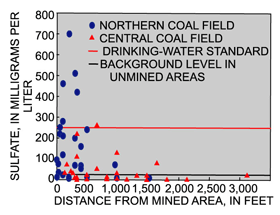 |
| Figure 24. Sulfate concentrations in ground water generally exceeded regional background levels within about 1,000 feet from surface coal mines. |
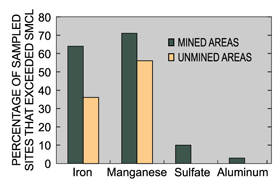 |
| Figure 25. Ground water exceeded Secondary Maximum Contaminant Levels in mined areas more often than in unmined areas. |
| Table of Contents || Previous Section || Next Section || Glossary U.S. Geological Survey Circular 1202 Suggested citation:
|


